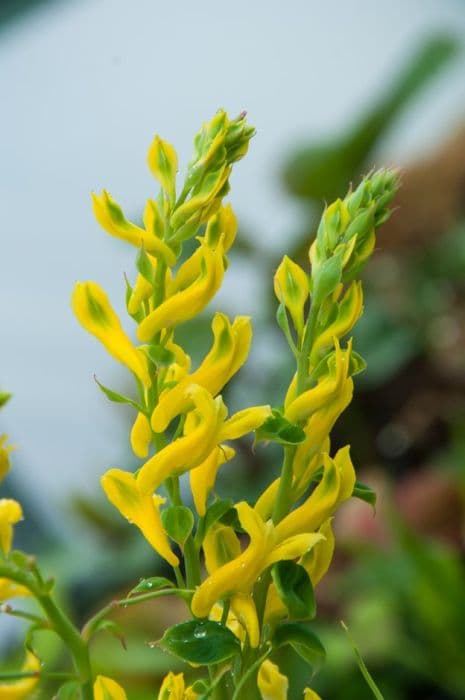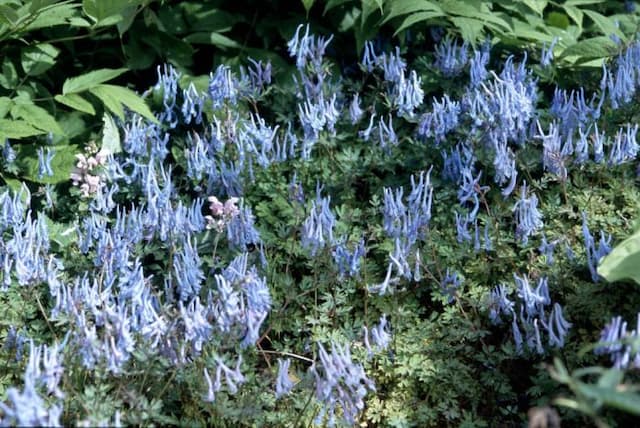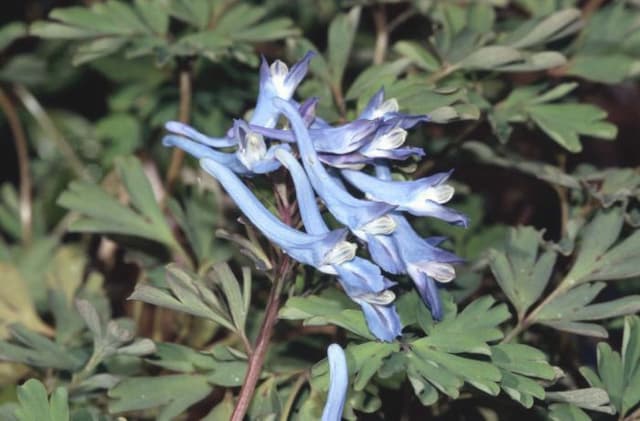Plume Poppy Macleaya × kewensis 'Flamingo'

ABOUT
The 'Flamingo' is a striking ornamental plant known for its distinctive foliage and unique flower plumes. Its leaves are a soft, gray-green color, deeply lobed, and have a subtle, dusty texture that gives them a somewhat silver look. This dusty overlay can cause the leaves to appear bluish or grayish in different lights. The foliage forms a lush, rounded clump that serves as a beautiful backdrop for its flower spikes. The blooms are perhaps the most remarkable feature of the 'Flamingo'. They emerge in mid to late summer, rising above the foliage on tall, upright stems. The flowers themselves are small and intricate, typically taking on a pinkish hue. They are densely packed into long, slender, bottlebrush-like plumes that can add a soft and feathery texture to the garden. These plumes can look airy and delicate, creating a contrast against the bolder foliage beneath them. The subtle interplay of color and form makes the 'Flamingo' a favorite among gardeners who wish to add a graceful, vertical element to their borders or beds without overwhelming the surrounding plants. It can serve as an excellent focal point, yet it remains versatile enough to complement a wide range of garden styles and themes. Overall, this plant exudes elegance and a gentle, yet distinct presence in the landscape.
About this plant
 Names
NamesFamily
Papaveraceae
Synonyms
Plume Poppy, Bocconia
Common names
Macleaya × kewensis 'Flamingo'.
 Toxicity
ToxicityTo humans
Plume Poppy, as Macleaya × kewensis 'Flamingo' is more commonly known, contains several isoquinoline alkaloids which can be toxic to humans if ingested. The plant's sap can also cause skin irritation and dermatitis on contact. If parts of the plant are consumed, the alkaloids may cause symptoms such as nausea, vomiting, dizziness, and diarrhea. In severe cases, the toxic compounds can lead to more serious symptoms including trembling, paralysis, and respiratory failure. Due to these potential effects, it is advisable to handle this plant with care and ensure it is not ingested.
To pets
Plume Poppy is also toxic to pets and contains the same isoquinoline alkaloids that affect humans. If pets ingest parts of this plant, they may experience symptoms of toxicity similar to those in humans, including vomiting, diarrhea, lethargy, and trembling. In more severe cases, ingestion can lead to respiratory difficulties, paralysis, and even death. It's important to prevent pets from chewing on any part of the plant and to seek veterinary care immediately if ingestion is suspected.
 Characteristics
CharacteristicsLife cycle
Perennials
Foliage type
Deciduous
Color of leaves
Blue-green
Flower color
Pink
Height
5-6 feet (1.5-1.8 meters)
Spread
2-3 feet (0.6-0.9 meters)
Plant type
Herb
Hardiness zones
5
Native area
Hybrid
Benefits
 General Benefits
General Benefits- Ornamental Value: Macleaya × kewensis 'Flamingo', commonly known as Plume Poppy 'Flamingo', is highly appreciated for its visually striking, plume-like pink flowers and large, decorative leaves adding a dramatic flourish to gardens.
- Drought Tolerance: Once established, Plume Poppy 'Flamingo' is tolerant of drought, reducing the need for frequent watering and making it suitable for xeriscaping or other low-water garden designs.
- Low Maintenance: This plant does not require regular fertilization or pruning, making it an ideal choice for gardeners seeking a low-maintenance landscape addition.
- Pest Resistance: Plume Poppy 'Flamingo' is rarely affected by pests, minimizing the need for chemical treatments and making it an eco-friendlier garden choice.
- Attracts Pollinators: The flowers of the Plume Poppy 'Flamingo' attract a variety of pollinators such as bees and butterflies, supporting local biodiversity.
- Landscape Design Versatility: Due to its height and structure, it can serve as a background plant in borders or as a focal point in landscape designs.
- Deer Resistance: It is generally resistant to deer, which can be beneficial in areas where deer browsing is a problem for gardeners. li>Easy Propagation: The plant can be easily propagated by division or seeds, allowing gardeners to expand their plantings without additional cost.
- Soil Adaptability: It is adaptable to a range of soil conditions, though it prefers well-drained soils, easing the requirements for soil amendments.
 Medical Properties
Medical PropertiesThis plant is not used for medical purposes.
 Air-purifying Qualities
Air-purifying QualitiesThis plant is not specifically known for air purifying qualities.
 Other Uses
Other Uses- Macleaya × kewensis 'Flamingo', commonly known as Plume Poppy, can be used as a source for natural dyes, providing subtle hues to fabrics when processed correctly.
- In garden design, Plume Poppy's tall and architectural form can be used to create a vertical accent or a natural backdrop for other flowering plants.
- The dried seed heads of the Plume Poppy can be used in floral arrangements to add an interesting texture and shape, enhancing the variety in a bouquet.
- Plume Poppy's extensive rhizome system can stabilize soil on slopes or banks, helping to prevent erosion and support the soil structure.
- The stems of the Plume Poppy, being quite robust, can be repurposed in the garden as natural stakes for supporting other plants.
- Leaves of the Plume Poppy can be used in compost as a green layer, contributing to the nutrient content and decomposition process.
- The plant can provide a habitat for beneficial insects, including certain bees and butterflies that are attracted to its flowers.
- As a subject in photography or art, the Plume Poppy adds a dramatic flair due to its towering height and impressive inflorescences.
- The plant's unusual foliage can be used in the study or teaching of plant morphology and botany due to its unique characteristics.
- For novice gardeners, the Plume Poppy serves as an excellent plant for practicing division techniques because of its clumping growth habit.
Interesting Facts
 Feng Shui
Feng ShuiThe Plume Poppy is not used in Feng Shui practice.
 Zodiac Sign Compitability
Zodiac Sign CompitabilityThe Plume Poppy is not used in astrology practice.
 Plant Symbolism
Plant Symbolism- Resilience: Macleaya × kewensis 'Flamingo', commonly known as Plume Poppy 'Flamingo', is a hardy plant that can thrive in a variety of soil types and climates, representing the ability to withstand adversity.
- Grace: The delicate and feathery plumes of the 'Flamingo' variety evoke a sense of grace and poise, symbolizing an elegant and refined beauty.
- Standout Individuality: With its tall stature and unique appearance, the Plume Poppy 'Flamingo' can symbolize standing out from the crowd and celebrating one's individual uniqueness.
- Growth: As the Plume Poppy 'Flamingo' can quickly reach a considerable height, it commonly represents growth and ascension, either in a personal or professional context.
 Water
WaterPlume Poppy, commonly known as Macleaya × kewensis 'Flamingo', should be watered deeply but infrequently, allowing the soil to dry out slightly between waterings to prevent waterlogging. Watering should occur approximately once a week during the growing season or whenever the top inch of soil feels dry to the touch. Generally, a good soaking might involve 1-2 gallons per plant, depending on the size and the environmental conditions. During periods of drought or extreme heat, the frequency may need to increase, while in cooler weather or periods of rainfall, it may decrease.
 Light
LightFor the Plume Poppy, proper lighting entails full sun to partial shade conditions. The best spot would be an area that receives at least six hours of direct sunlight daily with some dappled afternoon shade in hot climates to prevent leaf scorch. Avoid deep shade, as it can lead to leggy growth and reduced flowering.
 Temperature
TemperaturePlume Poppy thrives in a wide range of temperatures but prefers a moderate climate. It can tolerate temperatures as low as 20°F in winter and can survive up to the lower extremes of 90°F in the summer. The ideal temperature range for vigorous growth and optimal flowering is between 60°F and 75°F.
 Pruning
PruningPruning is essential for the Plume Poppy to maintain a tidy appearance, encourage bushier growth, and remove spent flower stalks. It should be pruned back hard in late winter or early spring before new growth starts. Deadheading, or cutting off the faded flowers, can also be done in summer to prevent self-seeding and to promote additional blooming.
 Cleaning
CleaningAs needed
 Soil
SoilPlume Poppy 'Flamingo' thrives in well-draining soil enriched with organic matter. Aim for a soil pH of 6.0 to 7.0 for optimal growth. A mix of loam, peat, and coarse sand or perlite can create a suitable environment for this plant.
 Repotting
RepottingPlume Poppy 'Flamingo' typically doesn't need frequent repotting as it's mostly grown as a garden perennial. It can be divided every 3-4 years to maintain vigor and to control its spread.
 Humidity & Misting
Humidity & MistingPlume Poppy 'Flamingo' is adaptable to a wide range of humidity conditions and does well in the typical outdoor humidity levels without needing specific adjustments.
 Suitable locations
Suitable locationsIndoor
Provide bright indirect light and avoid overwatering.
Outdoor
Plant in full sun to partial shade in fertile soil.
Hardiness zone
3-8 USDA
 Life cycle
Life cycleThe life of the Plume poppy 'Flamingo' (Macleaya × kewensis 'Flamingo') begins with seed germination, which requires a period of cold stratification to break dormancy. Following germination, the seedling stage involves the emergence of the first true leaves and the establishment of a root system. As it enters the vegetative growth stage, the Plume poppy develops a robust clump of large, deeply-lobed leaves on tall stems, and this growth continues through spring and early summer. The reproductive stage is marked by the production of striking, feathery plumes of flowers during the summer months, which are a magnet for pollinators. After flowering, the plant sets seed, which, if not collected for propagation, may self-sow in the garden, completing the reproductive cycle. As a perennial, the above-ground foliage dies back in the fall with the root system remaining dormant through the winter, ready to begin the cycle anew in the spring.
 Propogation
PropogationPropogation time
Spring to Summer
Propogation: The Macleaya × kewensis 'Flamingo', commonly known as Plume Poppy 'Flamingo', is typically propagated by division, usually done in the spring before new growth begins. To propagate Plume Poppy 'Flamingo', carefully dig up an established clump and divide the root ball into smaller sections, ensuring each section has a portion of the root system and a few shoots. Divisions should be replanted at the same depth they were growing previously and watered well to establish. This provides a reliable method to create new specimens that are true to the parent plant, and it also helps to manage the size and spread of these vigorous perennials, as they can become quite large and may require some containment in the garden setting.









